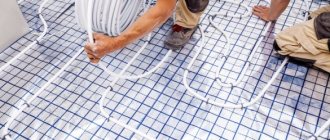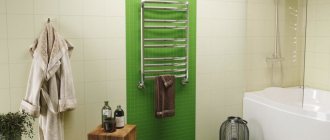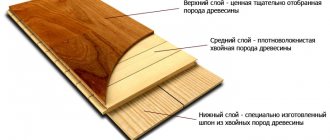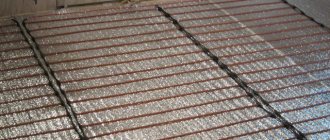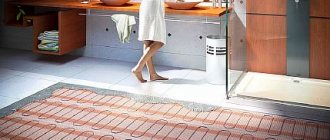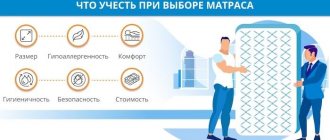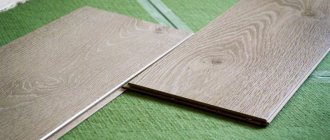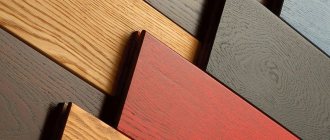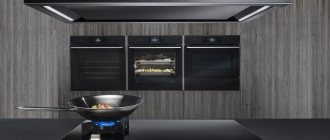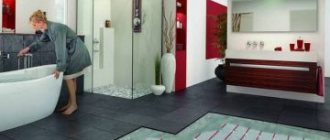The main advantage of ceramic tiles is the possibility of laying them on any of the existing heating systems: water or electric, since they have high thermal conductivity.
If the question is which type of heated floor is best to choose for tiles, then our answer is electric , because it is easy to install and does not put pressure on the ceiling like a water heating system.
Let's take a closer look at all floor heating devices used under tiles to find out which is better in each specific case.
Rating of electric heated floors
The efficiency and high level of comfort of heated floors was appreciated by property owners. With the advent of the first systems, a number of problems were identified, which manufacturers began to actively correct. As a result, over the course of several years, cable and film heated floors and heating mats appeared on the market. We decided to figure out which systems are the best for different types of flooring. Experts tested the complexity of installation and efficiency, and compared the declared parameters with practical characteristics. User reviews, opinions of professional installers and heating engineers were analyzed.
When compiling the rating, special attention was paid to the following characteristics:
- Specific power – affects energy consumption and the level of comfort in the room;
- Installation method - manufacturers recommend installing different heating elements in a screed, a layer of adhesive or under the floor covering. This affects the timing and cost of installation;
- Level of electromagnetic radiation - low levels make the system safe for health;
- Efficiency - affects the profitability of the heating system;
- Functionality - the presence of a thermostat allows you to ensure a level of comfort and save on electricity, maintain the optimal temperature in the absence of property owners;
- Heating temperature – affects the thermal characteristics of the system;
- Protection from dust and moisture - the protection class has become an important factor when choosing equipment for a bathroom, open balcony or terrace.
Not all kits satisfied the requests of our experts. High electromagnetic radiation, low heat transfer, lack of components on the market, numerous negative user reviews - such systems were excluded from our rating.
Warm floors in the bathroom - pros and cons
After bath procedures you always want comfort. But this is out of the question if you step from a hot bath onto ice tiles. Do you want to get rid of this problem? This means it’s worth thinking about installing heated floors. After all, this equipment can add comfort to everyday life, improving the state of the immune system and overall well-being.
The creation of such additional heating in a bath room has long been a source of controversy. Some talk about the high risk of injury and sky-high prices. Others, on the contrary, praise fictitious “virtues.” Therefore, all the advantages and disadvantages of heated floors should be considered in more detail.
The best electric floors under tiles
A cold floor causes discomfort especially if ceramic tiles are used as the finishing coating. This is a practical material that is used in finishing bathrooms, kitchens, halls, and living rooms. More than 75% of heated floors are laid under ceramic tiles and porcelain stoneware. The basis for these materials is a screed, so the optimal solution would be to use heating mats and cable systems designed for wet installation for heating.
Such a warm floor under tiles will consume a small amount of energy, and due to the high thermal conductivity of ceramics, it will provide uniform heating and good heat transfer. The VyborExperta.ru project analyzed 7 types of products from well-known manufacturers and selected 3 of the best.
Warm floor No. 1 TSP-150-1.0
A Russian-made heating mat made on the basis of a two-core wire. The heating cable has a small diameter - a cross-section of 3 mm allows it to be laid not only in the screed, but also in tile adhesive. The wire is attached to a polymer mesh, which has good adhesion to cement-based adhesives. This increases the reliability and service life, and the intervals between scheduled repairs of the floor covering.
The heated floor is supplied in strips of 2x0.5 m format. The pitch is very convenient, it makes laying heating mats as simple as possible in rooms with a complex layout. The power of the set is 150 W, which helps reduce heating costs. The maximum heating temperature of 80 degrees makes installation outdoors possible.
Advantages:
- High heating rate;
- Manufacturer's warranty 20 years;
- Service life of at least 50 years;
- Low price;
- Corrugated tube for temperature sensor included.
Flaws:
- Not found.
The manufacturer produces a wide range of self-regulating and resistive cables, which has a positive effect on reducing prices. For the heated floor, a core in fluoroplastic insulation was chosen, which can withstand temperatures up to 200 degrees and ensures trouble-free operation of the heating mat.
Warmstad WSM-300-2.0
The heating mat is based on a two-core wire laid on a mesh made of strong and durable polymer material. The total thickness is only 4 mm, which allows you to lay the heated floor in an adhesive solution before installing the tiles. This has a positive effect on the parameters of the “pie” and does not raise the floor level.
Supplied in the form of mats of 4x0.5 m format, heated floors can be used for main and additional heating systems. The roll is easy to unfold, allowing you to quickly complete installation in rooms with complex layouts. Specific power 150 W/sq.m. makes underfloor heating economical and comfortable for use as additional heating. The mats are designed for rooms with normal and high humidity.
Advantages:
- Good insulation quality;
- Manufacturer's warranty 25 years;
- Good shielding;
- Mounting tube included;
- Low price.
Flaws:
- Low quality couplings.
SpyHeat Classic SHD-15-600
The heating cable is intended for laying in the screed or in the adhesive layer when installing tiles. A two-core resistive wire with a power of 15 W/m can be used as main and additional heating under a finishing coating with high thermal conductivity. A special feature of the cable is its oval cross-section; the wire is thin and does not affect the floor level in the house.
The set is designed to heat 5 sq.m. floor, when used for main heating - 3 sq.m. Laying the cable will avoid the “zebra” effect and ensure uniform heat distribution over the entire area. To protect the cores from the negative influence of cement mortar, the manufacturer used a fluoroplastic shell.
Advantages:
- Resistant to local overheating;
- Fast heating of the room;
- Manufacturer's warranty 50 years;
- The laying step can be changed in the range from 5 to 15 cm;
- It is convenient to work in rooms with complex layouts.
Flaws:
- Difficult installation.
Cables
This is the simplest and cheapest type of heater; outwardly it looks like an ordinary wire. The cable is secured to the floor using clamps, after which the screed is poured. If the cable is thin, it can be installed in a layer of tile adhesive. A single or two-core cable can be used; they differ in the connection method. During installation of the first option, it is necessary to create a closed loop, that is, bring both its ends to one point.
Regardless of the type of cable used, it works on the same principle: during the passage of current, the conductors heat up and transfer heat to the screed, after which it is evenly distributed throughout the room.
It is recommended to install a two-core cable in the bedroom, and in a room where people visit less often, you can get by with a single-core cable; this will help save your budget when purchasing the materials necessary for installation. If you want to lay a heated floor under electric tiles with your own hands, first you need to study the installation features of the system.
The best electric heated floors for laminate
The popular finishing flooring has a “warm” design, but property owners always experience a little discomfort with tactile contact. The laminate used in a heated floor system must have a thickness of at least 8 mm. Infrared tapes or a thin heating mat can be used as a heating element for dry installation at any stage of the repair. Heating cables and classic electric mats for heated floors are used when preparing the screed.
Teplolux Express
A unique solution for those who have not decided to install heated flooring under laminate. They came up with equipment for an additional, portable heating system. The Express heating mat can be installed on laminate flooring. The heating system based on a thin heating cable will not harm the finished floor covering. The mat is covered with a carpet on top, plugged into the network and used as an additional source of heat in a nursery, office, living room or country house.
Dimensions of the heating mat are 2x1.4 m, power 300 W. Heating equipment can be used in a small room during the off-season, in rental housing. The heating element has a dense, elastic shell made of practical artificial felt.
Advantages:
- The mat is ready for use;
- A convenient bag is provided for carrying;
- Universal plug;
- Dust and moisture protection class IPX7;
- Maximum surface temperature 30 degrees.
Flaws:
- Time to reach operating mode is 60 minutes.
Devi Devicomfort 150T
Heating mat based on a thin two-core wire. The total thickness of 4 mm allows you not to worry about the fact that installing a heated floor will have a strong impact on the height of the ceilings. The self-adhesive surface simplifies installation: the mat is well fixed to a clean, primed floor, and the floor covering is laid on top. Includes a roll with an area of 4 sq.m. (length 8 m). Specific power 150 W/sq.m. allows use for main and additional heating.
Maximum heating temperature 70 degrees. The aluminum screen increases heat transfer, increasing the efficiency of the system. External PVC insulation guarantees reliable protection against mechanical damage.
Advantages:
- PTFE cable insulation protects against local overheating;
- Manufacturer's warranty 20 years;
- Teflon internal insulation;
- Connecting cable 2.3 meters included;
- Good bend radius.
Flaws:
- High price.
XiCa RexVa XM-305
The South Korean company offers an ultra-thin infrared heated floor for laminate with a width of 50.5 cm. The thickness of the film base is 0.338 mm, while the power density reaches 220 W/sq.m. Supplied in sheets 2 meters long. The technical characteristics allow the heating elements to be used as the main heating system for heating a country house, office or cottage.
The film emits waves in the infrared range, with a length of 5 to 20 microns, which heat not only the laminate, but also furniture. This increases the rate at which the room warms up. During operation, the surface of the heating element heats up to 50 degrees, and at peak values it can withstand temperatures of up to 130 degrees. The film is self-extinguishing and does not support combustion. It is laid on thermal insulation made of foamed polyethylene, which is purchased separately.
Advantages:
- Low price;
- Minimal electromagnetic radiation;
- Dry installation;
- High efficiency – 90.5%;
- Economical.
Flaws:
- Additionally, you need to buy a thermostat and an installation kit.
Electrical cable
Considering reviews about the use of heated floors that are mounted under tiles, it should be noted that one of the acceptable options is the electrical cable system. It consists of a core through which current is supplied. It heats the material (most often it is a nichrome alloy). There are several different protective sheaths around the core. They protect the inner core from adverse influences.
The cable has a thickness of about 7 mm in cross section. It can be double or single core. In the first case, the heating cable has an end sleeve on one side, and a connection wire on the other. This is the most advanced system. Nowadays it has almost completely replaced single-core wire. The presented system is easier to install and operate.
Single-core wire does not have a termination. It has a wire on both sides for connection. This makes installation somewhat more difficult.
The presented type of system must be installed in a screed with a thickness of at least 3 cm. A layer of insulation is mounted on the base of the floor. A reinforced metal mesh is laid out on it. The wire is laid out on it. The screed must include a plasticizer.
The best electric linoleum floors
In underfloor heating systems with linoleum, it is recommended to use IR film. This material ensures uniform heating over the entire area, and thermostats help set the temperature with high accuracy. At temperatures above 28 degrees, linoleum may begin to stretch, which will negatively affect the quality of the material. A special feature of infrared film is the ability to provide comfortable air temperatures at a low level of heating of the floor covering. The VyborExpert.ru team studied reviews of electric heated floors of domestic and foreign production. Experts selected 7 film floors for testing and suggest paying attention to the products of three brands.
Electrolux ETS 220-4
The kit from the Swedish company is designed to heat 4 sq.m. usable area. Infrared film with a thickness of 0.338 mm is resistant to high temperatures - up to 110 degrees. The heating elements are made of carbon and can be used in living rooms, on open terraces and areas. The delivery set includes everything necessary for installation: wiring, clamps, electrical tape.
Specific power 220 W/sq.m. allows the use of heated floors for auxiliary and main heating. IR elements quickly heat the floor covering and furniture, which release heat to the air and create comfortable conditions in the room. Electricity consumption is significantly lower than that of cable heating systems due to high efficiency.
Advantages:
- Resistant to corrosion of all elements;
- The degree of protection against moisture and dust corresponds to class IP52;
- Dry installation;
- Minimum levels of electromagnetic radiation;
- Manufacturer's warranty 15 years.
Flaws:
- High price of the kit.
Eastec Energy Save PTC
A new generation heating film in an easy-to-install 1x1 m format. A self-regulating heating element at the point of local overheating reduces the load by 25-30%, which protects the linoleum from temperature deformations. The IR film is based on carbon elements, reliably protected from moisture and mechanical damage by high-strength electrical polyester. Specific power 220 W/sq.m. makes the heat source universal.
The conductor bars are made of high purity copper, the contacts are made of silver paste. Design features have a positive effect on the efficiency and profitability of the application. It is allowed to use the film in open areas and in living rooms. Maximum heating temperature 60 degrees. It is recommended to lay in strips up to 8 meters, with a cutting line step of 25 cm.
Advantages:
- Convenient installation;
- Manufacturer's warranty 15 years;
- Service life 50 years;
- Electricity consumption is 30% lower than competitors in its class;
- High thermal safety of the base.
Flaws:
- The kit does not include a thermostat or mounting “crabs”.
National comfort PNK 220
Practical infrared film for dry installation under linoleum. The base is a carbon element with a long service life. The outer shell is made of durable lavsan fabric, which can withstand significant static loads. The film format is convenient for working on balconies, in living rooms with complex layouts and offices.
Specific power 220 W/sq.m. makes the equipment relevant to the main heating system. The manufacturer offers to purchase an additional programmable thermostat. When installing this equipment, IR film will save up to 70% of electrical energy, and the ability to select the desired mode will help reduce heating costs when there are no residents in the house. Safety is ensured by double-layer insulation of wires.
Advantages:
- Uniform heating of the surface;
- Simple and quick installation;
- The floor level does not rise noticeably;
- No electromagnetic radiation;
- Fast warm-up;
- Good equipment.
Flaws:
- The warranty on components is only 1 year.
Reviews about the warm field
Today, the market for underfloor heating products offers a huge selection of different systems. They differ in operating principle, efficiency and cost. The water floor is created using a special pipe. It withstands temperature changes and quickly transfers heat to the screed. When installing this type of system, it is recommended to take a responsible approach to the choice of boiler. It must have sufficient rated power. The cost of heating will depend on the choice of energy carrier from which the equipment operates.
Electric heated floors are offered today by many domestic and foreign manufacturers. They differ in cost. Among domestic companies, the leader in this industry is Teplolux underfloor heating. This manufacturer produces high-quality electrical wires for external and internal heating. According to expert reviews, the quality of Russian wire is not inferior to its European counterparts. The cost of Teplolux products is 30-40% cheaper.
Among foreign companies, the leaders are such manufacturers as Davi, Nexans, Ensto, etc. They supply high-quality products, proven over years of impeccable service of the systems presented.
The best electric heated floors for wooden floors
Wooden floors are used in the implementation of exclusive projects, renovation of balconies and loggias, construction of dachas and country cottages from timber or rounded logs. The choice of heated floors for a wooden house is distinguished by a variety of solutions. If you have a subfloor, you can use film systems. When laying on logs, a heating cable is used, and additional slots are made in the timber for it. Installation on a concrete base allows the use of heating mats.
Unimat BOOST-0200
The heating mat was developed by South Korean engineers based on flexible heating elements. Elastic rods are made of a composite based on carbon, graphite and silver. Heating elements are capable of self-regulation: when the temperature rises above a given level, energy consumption decreases. This reduces electricity consumption by 1.5-1.8 times, which increases competitive advantages compared to analogues from other manufacturers.
The heating mat is mounted in a screed on which solid boards or parquet made of valuable wood can be laid. It works on the principle of infrared heating, quickly warming up the room. The delivery set includes a corrugated pipe with a probe and a plug, connection and end kits, wires for connections with double thermal insulation.
Advantages:
- Uniform heating of rooms;
- Installation on balconies and verandas is allowed;
- Does not dry out indoor air;
- During installation, you can use heat-reflecting material;
- Withstands high static load.
Flaws:
- Not found.
Caleo Platinum 230-0.5-2.0
Fifth generation infrared film for dry installation on subfloors. The improved silver mesh ensures fast heating and no sparks, while variable power and self-regulation reduce energy consumption by 6 times compared to analogues. Designed for residential premises and open balconies, loggias, verandas. Safety in rooms with high humidity is ensured by a high protection class IP57.
Specific power 230 V/sq.m. makes the film suitable for main and additional heating. The wavelength of infrared radiation 5-20 microns is completely safe for human health. Film area 2 sq.m. and connection components allow you to quickly complete installation without the involvement of specialists. Users note a high heating rate in the premises and a comfortable microclimate even on the coldest days.
Advantages:
- Does not dry out the air;
- Withstands high static loads;
- Service life 50 years;
- Overheat protection;
- Does not increase the thickness of the floor.
Flaws:
- The cable may not be enough.
HotPanel
Heating panels can be used as a rough floor covering. Designed for installation on concrete screed. The panels are made from an alloy based on aluminum and zinc, which is resistant to corrosion. Cost-effectiveness is ensured by a built-in heat shield made of polyurethane - heat will not escape through the ceiling to the neighbors. Engineers from South Korea paid special attention to the uniformity of the alloy thickness on the outer surface. This guarantees fast and uniform heating over the entire area.
The panels can withstand loads of up to 15 kg/sq.cm. The surface heats up to a temperature of 50 degrees, providing comfortable conditions. The power density makes underfloor heating an ideal solution for an additional heating system. The heating temperature is easy to adjust over a wide range, and the IP68 protection class is a guarantee of safety when used in areas with high humidity or outdoors. The panels can be used in a vertical position.
Advantages:
- Simple installation with the possibility of dismantling;
- Good heat dissipation;
- Protective screen from electromagnetic radiation;
- Fast payback;
- Universal application.
Flaws:
- You cannot change the panel format.
Warm (water) floor - reviews
Anonim
https://forum.derev-grad.ru/otoplenie-i-kotli-f153/otzyvy-pro-teplye-vodyanye-poly-t5177.html
Simason wrote:
“All my childhood I walked barefoot on the floor without heating in a private house and survived
well, barefoot, socks, slippers and everything is ok. There was linoleum on the floor then, yes, tiles only in the bathroom.
For me, heated floors are a waste of money... for those who decide to show off and show off. There’s more hassle with him.”
...I also lived in a private house and even more than half in a Japanese barracks...the simplest solution in winter is winter rugs (children’s duty is to shake out the rugs every 3-4 days in the snow, always hemmed slippers and “socks” knitted from footwear to golf on a strong cold... barefoot on the floor - wash your feet often, and water in buckets from the well and warm on the stove
Oleg Zhuvchik
https://srbu.ru/otopitelnye-pribory/1110-teplyj-pol-vodyanoj-otzyvy.html
Recently, more and more people are refusing conventional heating with radiators, so I decided to abandon them and entrust the heating to the Valtec water heated floor. Why did I choose this company? Everything is very simple, this company uses polyethylene pipes, which are distinguished by their high reliability, quality and durability.
Initially, you need to level the floor surface, then you need to lay insulation, which will prevent heat from passing down. I laid 20 mm thick penoplex. A reflective film was placed on top of it. In general, it is not necessary to install it, but since there is a basement below us, I decided that it would be safer with it.
Then he moved on to installing the pipes, securing them with staples. I connected the ends of the pipes to the distribution manifolds and filled everything with screed. I waited for a month, after which I started using warm water floors.
Pros:
accessibility, reliability, ease of installation, energy efficiency
Minuses:
If installed incorrectly, the floor may rise, along with the entire floor covering
Asya
https://www.babyblog.ru/community/post/housedesign/1701076
We have water heaters throughout the house, they are heated with gas - it's cheap. It’s just super, the legs are warm and pleasant, the baby sits and doesn’t freeze. On the 1st floor we have tiles on the floor, they are always cold. but no, for 2 the laminate is special for heated floors. If there is a leak, then open it. but if they do it right for you, there will be no problems. I'm very pleased.
Elena Marcion
https://vk.com/topic-66359412_32629496
A year ago, the idea came up to make a separate room out of the loggia - the space allowed, it was only necessary to figure out how to make it warm in winter. We decided to use the Thermotech polystyrene system - the rest of the apartment had been renovated and there was no desire to mess with concrete.
The installation was done quickly, the finishing coating was laid the next day - everything took just a weekend. We waited until winter to test the effect. It’s really warm on the loggia, even on the coldest days - just like in the apartment. Friends claimed that the windows would sweat - nothing like that! Very pleased. We didn’t notice any changes in utility bills, so I recommend it in every sense!
e_kuznetsov
https://www.mastergrad.com/forums/t132452-ispolzovat-vodyanoy-teplyy-pol-kak-osnovnoy-istochnik-otopleniya-ili-net/
I'll be the first. With proper calculation and installation, a water heated floor can be used as a source of main heating. Air circulation throughout the room when using radiators goes from the radiator up to the ceiling, cools along the ceiling to the opposite wall and falls to the floor along the floor again to the radiator and the process is repeated. When using a Water Heated Floor, the working area of the floor is heated and air rises from the floor to the ceiling over the entire working area of the floor. Set the power to more than you need. You can always reduce the temperature, but you can’t increase it. https://www.mastercity.ru/showthread.php?t=7302 Here is the main thread Useful information for you.
Seven-seater
https://forum.auto.ru/housing/6573188/
if the battery is hot, then there is circulation, that is, the pressure at the inlet is greater than at the outlet. If the inlet and outlet are connected with a copper tube, it will also be warm. Turn on the taps and don’t worry. Automation and pumps are from the evil one. They were invented by the bourgeoisie to breed suckers
Dimon
https://www.allbeton.ru/forum/topic9712.html
There are so many pipes with water (and more) in the ground - you need to fly! Don't your wings itch?
Semyon
https://www.stroy.ru/cottage/com-heating/questions_1383.html
That Hit Life - they put a review on themselves here
Warm floor No. 1 is Chinese, but supposedly produced in Russia, formed in 16, they give a guarantee from 20 years to infinity. But I am sure that in 1.5 years it is not possible to organize production and take into account all the subtleties and heal your problem areas in the product, it is not possible. Therefore, cables often fail. The company started with deception right from the start. I don’t recommend it, although they made fake videos, you can see from the walls that there are different production rooms there. Most likely they buy the cable in coils in China, and in Mytishchi they connect it to the power end in their garage. In the video where the machines are, you can immediately see that the room where the coupling is taking place is not the same; most likely, they filmed something other than their own production facility.
And a review was even written here about a stupid guy who bought an infrared heated floor (of course, any heater is infrared, but usually in 99% of cases an infrared heated floor is called infrared film), and its insulation is fluoroplastic...
Fluoroplastic is used as insulation for cables, not for film.
Teploff also writes his own reviews here.
I advise everyone not to fall for marketing and advertising, but to buy time-tested options
madesik
https://otzovik.com/review_2565880.html
Advantages:
Convenient, comfortable, economical, warm.
Flaws:
I don't know the downsides.
Good afternoon, dear readers! I will talk about heated floors from the point of view of a housewife. I will not cover the technical aspects. We bought a cottage with the floors already installed. We knew it was very good, but we didn’t expect it to be so good. This is the case when the fact exceeds expectations. With the onset of autumn and chilly weather, you walk into the house and your feet immediately feel warm. Especially convenient for children. And the guests are always pleasantly shocked. The shoes dry immediately. Everything is very economical. Warm air rises to the top. The next year a bathhouse was built. We immediately decided to have warm floors! For a bath it is even more convenient and enjoyable. After all, you heat the bathhouse, but the floor remains cool. But now the problem is solved. We enjoy our floors every day.
sergiokamaro
https://otzovik.com/review_5233678.html
Advantages:
Savings, comfort, increasing the service life of the boiler.
Flaws:
installation technology
So, first of all, the room in which the installation will be carried out must have a rough screed at a level of at least 10 cm from the floor level and preferably plastered walls. We lay 30 mm thick polystyrene foam on the floor, 50 mm for basements. We lay a damper tape along the contour of the floor (so that the screed does not crack and heat does not escape to the walls). Next, we lay down the film for the heated floor with markings (the film should be dense, it’s better not to skimp here). We install heated floors. The length of the pipe of one circuit should not exceed 120 meters. We pour the floor by adding a plasticizer to the concrete so that it is as dense as possible and there is no air. Valtec equipment will allow you to perform all this work efficiently and quickly, and you can also get advice from a specialist on selecting the right equipment.
Rosbunker
https://otzovik.com/review_3209882.html
Advantages:
Comfort, low energy consumption.
Flaws:
Specialists are needed for installation; the installation procedure is quite expensive.
Greetings to all! In contrast to the above reviews, I have personal experience in servicing and installing Valtek as a low-temperature heating system both in the private sector and in industrial premises. To begin with, I’ll tell you how this whole movement works and exists: 1 Coils with a pipe have a length of 100 meters, based on these indicators, you need to divide the area of the room into so-called loops (100 meters is, in principle, the limit of the working length of a loop, no matter what anyone says: you can join press crimp, etc. all nonsense) 2 When installing on a concrete base, thermal cutoff of this base is required, we use extruded polystyrene foam (all sorts of foil and other substrates with aluminum coating are unsuitable, chemistry lesson 8th grade, aluminum in contact with silicate, alkaline medium, dissolves). 3 There are 2 ways of laying a pipe, the so-called snake and snail, a snake will fit you in a room no more than 4 meters, in larger areas a snail is laid (more comfortable heat distribution due to alternating *supply* and *return* pipes 4 When choosing, still water floor or electric, don’t forget not only about the difference in operating costs (electric heating is strikingly different from the same system of water-heated floors powered, for example, from a gas or solid fuel boiler) but also about your health: here it’s physics; any consumer of electric energy spreads a magnetic field, imagine what level of electromagnetic radiation there will be, for example, in a children's room with quickly installed electrical mats? 3 exits 6 Heated floors should not be the only heating option in the house, I recommend installing good old radiators (bimetallic or copper or, in extreme cases, cast iron) with adjustable valves under the windows, this is done so that the windows do not * peel off (condensation on glass). The valves can be used to turn down or even shut off an unnecessary radiator at any time. 7 Do not forget that heated floors are a low-temperature option for heating a house; you should not expect that you can fry eggs on the floor, and this is harmful, the comfortable temperature of a heated floor varies from 18-32 degrees. 8 Savings during operation: low-temperature heated floors save up to 20% of resources (coal, firewood, gas, etc.) in contrast to the same room dimensions with only radiators installed. 9 Result: for yourself, of course, only water floors.
oskar359
https://otzovik.com/review_628530.html
Advantages:
accessibility, reliability, ease of installation, energy efficiency
Flaws:
If installed incorrectly, the floor may rise, along with the entire floor covering
Water underfloor heating is becoming very popular and I believe it has a number of advantages. We are used to radiator heating and it is difficult to get used to something new. I have many questions and doubts. But many people have already abandoned tradition, took risks and were not mistaken. There are a huge number of companies that now provide products for installing heated floors. Valtec is a well-known company in the professional circle. They have a huge assortment and I would even say that this company has everything you need for heating and water supply. Therefore, I can safely entrust my floor to Valtec products. What I like about Valtec is that they use XLPE pipes. (PEX-EVON). It is designated as PE-X or PE-S. To put it simply, ordinary polyethylene pipes contain molecules that are located nearby and are not connected to each other in any way, but here there are cross-links between them. Due to this, they are more resistant to high temperatures and more elastic. In them, the inner surface is also less rough and the canal does not become overgrown. There are also some minor drawbacks. Well, for example, it is difficult to maintain the bend, so it is fixed with clamps or staples. It also cannot withstand prolonged exposure to sunlight. Most often it is used in a closed gasket. That is, they are hidden either in the wall or under a concrete screed. Installation of any system must begin with leveling the surface. Irregularities are allowed, but not more than 10 mm. Then comes the insulation, which will not allow heat to pass down. In our case, it is penoplex. We chose 20 mm thickness. It is quite dense and ideal for underfloor heating. The options here may be different, but it is best to use foam materials with a density of at least 25 kg/m3. The next layer is reflective foam film. It may not be used. Usually it is laid if there is high humidity on the floor below. The strips of film must be glued together with tape. In general, a warm floor is a multi-layered salad. Every ingredient has its place. It is worth laying a damper strip along the perimeter of all side walls. It serves for thermal expansion of the floor. When the floor becomes solid and begins to heat up and expand, such a strip will prevent the floor from rising. Believe me, it’s a terrible sight when you get up in the morning and the tiles have burst and the cement screed has risen. All the money and time went down the drain. Therefore, such a small thing as a 10 cm wide strip can help avoid many problems. It should protrude 2 cm above the screed. Then we proceed to laying out loops of metal-polymer pipes around the room. There are two options. The first one is a snake. It is used for non-standard room sizes. Here you need to remember that the supply pipe must pass near the outer walls. Next is the snail. The most common. Here the heat is distributed evenly and the falling pipe is laid next to the return pipe. The pipes are laid parallel. The shape of the hinges depends on the room. The pipes are secured with brackets of the appropriate diameter. The staples are attached using dowel-nails to the concrete base. The ends of the pipes are connected to distribution manifolds. The heated floor system is connected directly to the boiler through a mixing control unit. You can install temperature sensors on the system that will regulate the temperature of your floor. Here you also need to know that if you install such a system in an apartment, then you will not be able to regulate the temperature here. What is given to you is what you will receive. And if, God forbid, the installation is incorrect, there is a possibility of flooding the neighbors below. And dismantling this entire layer cake is not a pleasant or cheap pleasure. For apartments, electric heated floors are still more often used. The next stage is laying the reinforcing mesh and pouring concrete into the pipes. After the screed is made, you need to wait 28 days until the cement dries completely. After this time, you can use heated floors. They say that from a physiological point of view, heating an area through the floor is close to ideal. Heat comes from bottom to top and is evenly distributed throughout the room. In terms of price, everything here is strictly individual. And I can’t say the cost. Because the pipes and components can be different, and again it all depends on the size and type of room.
Anna V.
https://irecommend.ru/content/kak-delaetsya-vodyanoi-teplyi-pol-vse-etapy
Installation of a warm (water) floor. Instructions.
1. Analysis of the existing original floor - concrete screed - for height differences. If the difference is more than 1 cm, it must be leveled. Apply primer to concrete.
2. We make “beacons” - that is:
- from a mixture of sand concrete M-300, strips-furrows are laid out on the floor at a distance of approximately 1.2 m from each other, on top - a thin metal strip of 10 mm (this is what is called a “beacon”);
— a laser level is set (in the photo there is a tripod with a yellow head), preferably so that it is “visible” from all corners of the room;
— this laser level “draws” an absolutely horizontal surface at a given height (say, 1 meter from the floor);
- a mark is made on some bar (for example, a rule), also at a height of 1 m;
- then, using this rule, we go through all the strips of sand concrete (of course, when the sand concrete has not yet dried) and set the desired height of the beacons by pressing them into the concrete.
3. In this way, a flat surface is achieved - so far only strips of concrete. The next step is to pour the same mixture of sand concrete between the strips and level it with a rule of 1.5 m wide. We get a relatively flat concrete surface.
4. There is an opinion that at this stage it is necessary to fuse waterproofing onto the floor, extending approximately 30 cm onto the walls. We limited ourselves to spreading Knauf - Flachendicht waterproofing on the walls around the perimeter (black stripe in the photo).
5. Damper tape - around the perimeter of the entire room.
6. Laying penoplex (Extruded polystyrene foam) - for floors. If the floor “lies on the ground,” that is, it is the first floor and there is no basement under it (and the height of the room allows), then the thickness of this layer should be 10 cm. Otherwise, you can make it 5 cm.
7. Laying thick polyethylene.
8. Laying a metal grid in increments of approximately 10 cm (on stands - for example, from pieces of plasterboard, since the concrete mixture must subsequently penetrate under this grid).
9. Laying a pipe (white in the photo) through which water will flow (diameter 20 mm).
Here, preliminary preparation is absolutely mandatory - that is, you need to know in advance how this pipe will be laid. For this, “advanced” people use special programs, incl. AutoCAD or at least Photoshop; not “advanced” - graph paper with an exact floor plan.
The distance between the pipes is approximately 30 cm. There are all sorts of installation tricks - this is a separate topic. Usually the hottest water is supplied closer to the sources of cold - to the windows.
The pipe is attached to the collector, and after installation, the entire system is checked for functionality (that is, warm water is running) and for the absence of leaks. The maximum length of the pipe is 120 m (the pipe is always solid). But the smaller it is, the smaller the temperature differences in the floor (since by the end of the journey the water has already cooled down).
10. The pipe is attached to the metal grating using ties. The “tails” are cut off.
11. And again - the same work on arranging “beacons”.
12. Final filling of the floor with concrete mixture (the main thing here is not to damage the pipe).
You can make the concrete mixture yourself (for cost-saving reasons), but it will be much better if you order a mixer (concrete mixer) - Concrete on granite (300). The height of the screed is 7 cm.
11. Then the screed should dry for about a month (some say 4 weeks), the period can be reduced to 3 weeks if after 10-14 days you turn on the heated floor (at minimum temperature).
12. Fill small potholes, remove unnecessary protruding stones (with rough pouring it is difficult to achieve a perfectly even floor). We prime.
13. Filling with self-leveling mixture. Mandatory for subsequent installation of laminate/parquet. Some people believe that if you plan to lay ceramic tiles or porcelain stoneware, then this stage is not necessary, since the floor will be leveled using tile adhesive (but we filled it - see the penultimate photo).
14. And finally! — laying the finishing coating. (we prime it first).
The photo shows porcelain tiles.
Note 1: Water heated floors are prohibited from being connected to a centralized heating or hot water supply system in apartment buildings, therefore this technology is used only in individual residential buildings and townhouses. The “advantages” of this floor are: cheaper operation (if the water is heated by a gas boiler) compared to an electric one and the absence of electric, electromagnetic and magnetic fields.
Note 2: The diameter of the pipe through which water flows is not less than 20 mm. Very often, to save money, they take 16 mm - this increases the load on the pump (the smaller the diameter, the more difficult it is to drive water through the pipe) + reduces the efficiency of the entire system, because the water cools faster.
The most successful pipe layout is a “snail”, when a hot pipe alternates with a cold one (which goes in the opposite direction), this way it is possible to avoid cold zones in the room. But this layout is not always applicable in real conditions.
Note 3: for a self-leveling mixture, craftsmen often recommend IVSIL (we took the green package TIE-ROD-III). It is advisable to buy in stores/companies where there is hope for correct storage conditions: this mixture is very delicate, the air is slightly more humid and lumps form inside the bag, which makes it unsuitable for use.
Olus
https://irecommend.ru/content/vodyanoi-teplyi-pol-pod-plitku-kafel-opyt-ispolzovaniya-5-let
One-room apartment in a nine-story brick building. Financially unlimited husband. The wife was expecting their first child. This is how our story of repair and acquaintance with water heated floors begins.
They decided to do a thorough renovation. They broke down walls here and there, fenced off the nursery, and made a dressing room. The kitchen was combined with part of the balcony to add space. All the kitchen furniture was ordered so that it fits compactly where the balcony was. The dishwasher was built into the wall. There were special needs for warmth, since the former balcony was poorly insulated! It was decided to install a heated water floor in the kitchen under matte ceramic tiles.
They invited workers and moved out during the repairs. Of course, we missed the deadline; we had to live with our grandmother with the newborn, but that’s another story)))
We return to our updated apartment: it’s unrecognizable! I go to the kitchen, stand on one tile, “Supeeeeer!!!! It’s warm!” But! There is a serious drawback - heat travels like a snake through the kitchen. And either this snake was laid for me too rarely, or “What did you want!?”... but now the whole family knows by heart the “route” of warm tiles in the kitchen!!! Yes, yes, they are not all warm. One is just a blast, and the neighbor next to her is not just cold, but icy! Especially where there used to be a balcony.
Here's a diagram of what happened:
My conclusion: heated floors are a good thing. But! The process of installing it should take place under the strict supervision of those who are interested in making life in the apartment pleasant! Either do it yourself or watch the workers. Otherwise we’ll have to jump from square to square like we do)))
kristina_fornarina
https://irecommend.ru/content/roskosh-ili-vygodateplo-moim-lapkam-znachit-net-prostude
Hello everyone, today I want to tell you about warm floors, because cold evenings have arrived, I think this topic will be relevant.
So, let's begin..
I live in a 16-story block house, in a 4-room apartment, it used to be always warm (even hot, I had to open the windows for ventilation in the winter), but now, after repairing the boiler room in our neighborhood, the heating is very weak, considering that the kitchen has access to the balcony and one of the bedrooms also has access to the loggia. (It’s especially cold in these rooms) Cold, wild.!!!
So my husband and I decided to fork out for this kind of pleasure. I’ll say right away that this pleasure is not cheap! For 80 m2 it cost us 70 thousand rubles (with installation).
But for 5 years now they have been heating without any breakdowns, ugh ugh ugh :)
We took Spanish floors, with a 16-year guarantee from the manufacturer.
These floors can be laid, as they explained to us, under any floor covering, they also took an electronic thermostat (Spain), what is the convenience of electronics - this is that there is an “office” mode, when we are not at home, from 9 am to 18 pm, the floors work offline and maintain a certain temperature.
Now, we are so used to them, this is something we find it difficult to live without; in the bathroom it is especially convenient!
It’s also good when you come home in winter or during rain, the shoes are slightly warmed up, thereby drying on their own and there is no wet snow on the floor.
One VERY IMPORTANT POINT!!! Once the installation of heated floors has taken place, they CANNOT be turned on for 28 days, because the floor screed has not yet dried. They can simply burn out!!! But believe me, it’s better to wait a month and everything will be in working order condition, than to then open up the entire floor covering and change the cable. Unfortunately, not everyone is warned about these points!!!:(And people, out of ignorance, often “bury” their money under the floor.
Regarding the communal apartment: I think it’s very profitable; in general, electricity costs us a maximum of 1,300 rubles, considering that the square footage of the apartment is not small, this is a good price.
CONCLUSION: This is a necessary thing, but only if it’s really cold in your home, the floors will be your main source of heating. But if you’re doing well with heat in the house, this is of course self-indulgence, my personal opinion.
PS cable we have Seilhit (Spain)
Warmth and comfort to everyone!
Darina Eva
https://irecommend.ru/content/teplyi-dom-v-kvartire-i-doma
our neighbor downstairs also “made” herself a heated floor (water) from a common radiator. Our temperature never rose above 18 degrees because of this! It’s true that she has it all over her 3-room apartment. It’s hot for her - she does less, accordingly, I’m generally stupid, and for 6 rubles a month I wanted to somehow not walk around the house dressed like a polar explorer. A couple of times she seriously drowned the neighbors below and they had to re-lay the floors again (this took 2 years). In short, it will all end with me filing a complaint with the heating network that it’s cold in my house, they will come, draw up a report, and begin to figure out what’s wrong with the system and they “chomp” the owner of the heated floors and say “don’t worry.” Officially, the fine is about 500,000 rubles in Moscow and the Moscow region! So this is not a joke. Don’t even think about letting your neighbors know that you have heated floors if you live in an apartment! Regarding the cheapness - yes, if it is “freeloading” with general house heat. And in my private house, underfloor heating in just 2 rooms costs 1000 per day! electric boiler! This takes into account that I live in Sochi! But, really, it’s very cool to cut across a heated floor!!! By the way, from my own experience, it is better to lay a special laminate with a thickness of no more than 7 mm. The tiles are very cold in summer, but give off heat better in winter
KUTSMAN
https://irecommend.ru/content/teplo-vygodno-ne-budet-dop-statei-v-kvarplatefoto
In my apartment, I made a water-heated floor in the bathroom and toilet by connecting it to a heating pipe. I made it from polypropylene pipes, soldering them together with bends at a distance of 10 cm. I also placed 3 taps in the wall: one shuts off the heating pipe, and the other two open the water floor. I filled it with a small layer of screed on top and laid the tiles. The expectations were justified, it turned out to be quite warm and no worse than electric ones, and most importantly, you don’t need to pay extra. If you install electric heated floors, then they waste electricity, for which you have to pay. When I asked if it was possible to make a heated floor from polypropylene in a plumbing store, they told me no, because it has poor heat transfer, make it with an analogue of metal-plastic specifically for heated floors. This pipe is already twisted in metal corners with metal taps, I think such a floor is not reliable. Since I myself have seen more than once how, after 10 years, a melallo-plastic pipe with hot water begins to collapse and leak. I advise you to make it from polypropylene, but the choice is yours whether to make it or not and from what material. Here I am attaching a photo before laying the tiles.
How to choose an electric floor
Buying the best heating mat or infrared film for your apartment, country house or cottage is the dream of every property owner. It is necessary to select products not only taking into account the manufacturer’s reputation and price, but also taking into account the operating characteristics. Which type of underfloor heating will be better for different types of coatings? This depends on the type of heating element, the power and connectivity of the thermostat, the class of protection against dust and high humidity.
Type
Manufacturers produce infrared film, heating mats and cables, and panels. The choice of equipment type depends on the type of floor covering and base. Most types of finishing flooring are laid on a screed. If the base is already ready, then you can use a film - a heating element of this type will not raise the finishing coating to a great height. Heating mats and cables can be laid in screed or in tile adhesive. This will provide additional protection against static load.
Infrared floors heat not only the floor, but also the furniture, which releases heat and makes the microclimate in the room cozy and comfortable. Mats and cables only heat the floor, which makes you think about the maximum possible surface temperature. Floors with infrared radiation have the least impact on human health. For other types of systems, care must be taken to have a protective shield against electromagnetic radiation.
Application
Warm floors are used as the main and additional heating systems. The main heat supply system must have a high power density - not lower than 220-230 W/sq.m. For additional heating, 150-180 W/sq.m is sufficient.
Heavy furniture can damage the heating element. If the heated floor will be under a high static load, then it is better to give preference to panels in an aluminum alloy casing or mats and cables that are laid in a concrete screed. It is recommended to install film floors under the finishing floor covering where it is not planned to install bookcases, heavy chests of drawers and washing machines.
When choosing products for installation on a balcony, in a bathroom, on an open terrace, you need to pay attention to the degree of protection. Products with protection class IP57 and higher have advantages. In regions with harsh climates, it is recommended to choose equipment designed to operate in a wide temperature range.
Thermostat
Thermostats maintain a stable set temperature. This has a positive effect on the indoor microclimate and helps reduce energy costs. Manufacturers do not always equip their heated floors of certain brands with this equipment, offering to choose the type of thermostat that best suits the buyer’s requirements.
Mechanical, electronic and programmable thermostats are available. Remote or built-in sensors can be used to control the temperature. Design features allow for built-in or surface-mounted installation, and connect the thermostat to a DIN rail. When choosing equipment, the temperature range and maximum power of the connected heating system are taken into account.
The most functional are programmable thermostats, compatible with different types of floors. They have high precision settings, child protection, several operating modes, and an informative control panel. This helps save the maximum amount of energy without losing a high level of comfort in the room.
Power
The total power of the heating elements determines the ability to maintain a given temperature in a room of a certain area. The calculations take into account the type of heating system, the amount of furniture, and the height of the ceilings. An accurate calculation can be made by a heating engineer who will take into account all the additional parameters of the operation of the heated floor.
When using electric floors as additional heating, it is recommended to install the most powerful heating elements on balconies and in bathrooms. Here the power should not be less than 180 W/sq.m. In living rooms, power is allowed in the range of 110-130 W/sq.m. This is enough to heat the floors and create a comfortable temperature in the room during the short off-season period. When purchasing equipment for the main heating system, these power indicators must be increased by 1.5-2 times.
Infrared film
The IR film is made in the form of mats, the thickness of which is no more than a millimeter, on both sides there is a layer of heat-resistant polyester, and between it there are carbon strips connected by copper busbars, they carry out the heating function.
Infrared film can be laid under different surfaces, even under parquet. First, the floor covering absorbs infrared radiation, after which it transmits it to the environment. Infrared film is afraid of moisture, so it is not recommended to install it in a screed or under tiles.
The heat generated by the cable or mat is retained longer in the screed or in the adhesive layer, so the thermostat can periodically turn off the power from the network and thus save energy.
Which electric floor heating is better?
A wide range of additional and main heating systems does not allow choosing a universal option for all types of floor coverings and operating conditions. Not all heated floors can be used outdoors. A number of kits are not suitable for installation in rooms with low ceilings. Our experts have determined which heated floor is better in different categories. We recommend using the advice of our team, which takes into account all factors - from price to functionality and configuration.
Among the systems that deserve special attention:
- Warm floor No. 1 TSP-150-1.0 is the best choice for tiled floors in city apartments and offices with installation in a concrete screed;
- Teplolux Express is a portable system for use in the off-season at the dacha, in a house or apartment;
- XiCa RexVa XM-305 – film for dry installation under laminate;
- Eastec Energy Save PTC - for laying under linoleum without installing a screed;
- National Comfort PNK 220 - an inexpensive system for installation in a country house or in a small country cottage;
- Unimat BOOST-0200 – for houses with wooden floors laid on a screed;
- HotPanel - for those who decide to insulate not only the floor, but also the panels.
All systems proposed by experts are reliable, have an impeccable level of safety and can reduce heating costs. Our team is ready to assign only such equipment the status of the best in its category.
Advantages and disadvantages
Before choosing and installing the type of heating presented, you need to weigh the pros and cons. Warm floors have many advantages over other heating systems. However, it also has disadvantages. First of all, certain difficulties during installation should be noted. In some cases, it will not be possible to install the presented type of heating without major repairs.
If the owners of a house or apartment choose a heated floor that is installed in a screed, they must take into account one nuance. This type of installation will raise the floor level by at least 7 cm. Often this type of installation of the system requires the creation of steps up to 15 cm high. In this case, the distance from the base of the room to the ceiling is significantly reduced.
However, in general, a correctly selected and installed system in accordance with all the rules will become a truly effective type of heating. It will not only be able to maintain the desired temperature in the room, but also consume less energy than standard heating devices. It is for this reason that heated floors are very popular today.
Undeniable advantages
Among the advantages of heated floors, it is worth highlighting the following facts:
- Reduced humidity levels.
- Uniform heating of the entire thickness of the air, and not just its upper layers.
- No discomfort when leaving the bathroom.
- Safety.
- Full control over the heating level.
The bathroom has a special microclimate, saturated with moisture and heat. These are ideal conditions for mold and mildew to form. But high-quality heated floors effectively dry the air, preventing the development and reproduction of pathogenic microorganisms. Therefore, the benefits of such equipment are undeniable.
How to get rid of excess moisture in the bathroom?
Unfortunately, heated floors cannot be installed over the entire area of the room. Therefore, droplets of condensation often remain in corners and at points of contact between plumbing fixtures and walls and other surfaces, creating an optimal environment for the development of mold and mildew.
Do you want to prevent fluid from accumulating in these areas? This means it’s worth purchasing a Doctor Sukhov dehumidifier. It is highly efficient, and installation of heating elements is possible on both horizontal and vertical surfaces.
The dehumidifier appears in the form of a cable fixed to the mesh. It can be easily installed under tiles or tiles. The equipment is equipped with a timer. Therefore, you can turn it on immediately after completing the bath procedures, and after heating the coating to 35 °C, the device automatically turns off. Minimum hassle and maximum efficiency.
A favorable environment in the bathroom is the key to the health of all members of your family. That’s why it’s so important to make this room as comfortable as possible! Modern heated floors and dehumidifiers will help with this.
